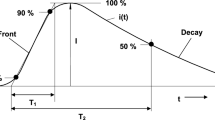Abstract
Corrugated stainless steel tubing (CSST) has been used for more than 20 years as a replacement for conventional black iron gas piping. CSST has a thinner tubing wall and is susceptible to damage from lightning activity when discharges enter a structure, potentially resulting in perforation of the CSST wall and fire ignition. Grounding has been promoted by CSST manufacturers as a solution to this problem. We use modeling and simulation of voltage potentials and arc currents to evaluate the effects of grounding on the voltage potential across CSST, which can result in arc initiation, and charge through the arc, which can result in melting and perforation of the CSST wall. Our results show multiple scenarios where a 10 kA 10 × 350 s current waveform with 1 \(\Omega \) grounding of the CSST still results in voltages greater than the arc initiation threshold of 25 kV and charge through the arc greater than 1.2 C, the perforation threshold we measured. For the case where lightning enters the structure through an outdoor light fixture or chimney, the presence of a grounding wire increases the charge through the arc from 0.13 C to 2.22 C. These results indicate that good grounding of CSST will not necessarily prevent arc initiation nor perforation of the CSST wall by lightning. Good grounding may in fact exacerbate the problem of lightning damage to CSST depending on where lightning enters the building and the electrical parameters of the path to ground.









Similar content being viewed by others
References
American Gas Association (1991) Interior fuel gas piping system using corrugated stainless steel tubing. ANSI/AGA LC-1-1991. American National Standards Institute
Durham RA, Durham MO (2012) Does corrugated tubing + lightning = catastrophic failure? IEEE Trans Ind Appl 48(4):1243–1250
Rivest DW (2006) Conductive jacket for tubing. US Patent 7,044,167, 16 May 2006
Lightning Protection Institute (2008) NFPA 54 (National Fuel Gas Code) to include bonding requirements. LPI Tech Lett 10(10)
National Fire Protection Agency (2015) NFPA 54: national fuel gas code
National Association of State Fire Marshals (2012) NASFM launches nationwide yellow CSST safety campaign
United States Senate (2012) Senate resolution 483: commending efforts to promote and enhance public safety on the need for yellow corrugated stainless steel tubing bonding
Hammerschmidt A, Ziolkowski CJ (2013) Validation of installation methods for CSST gas piping to mitigate indirect lightning related damage. Technical report, Gas Technologies Institute
Stringfellow MF (2013) Validation of installation methods for CSST gas piping to mitigate indirect lightning related damage: computer simulations of bonding effectiveness. Technical report, PowerCET
Rakov VA, Uman MA (2003) Lightning: physics and effects. Cambridge University Press, Cambridge, MA
Berger K, Anderson RB, Droninger H (1975) Parameters of lightning flashes. Electra 41:23–37
Anderson RB, Eriksson AJ (1980) Lightning parameters for engineering application. Electrica 69:65–102
Heidler F, Zischank W, Flisowski Z, Bouquegneau C, Mazzetti C (2008) Parameters of lightning current given in IEC 62305—background, experience and outlook. In: 29th international conference on lightning protection, Uppsala
International Electrotechnical Commission (2010) IEC 62305–1: protection against lightning. American National Standards Institute
Rakov VA (2012) Lightning discharge and fundamentals of lightning protection. J Light Res 4:3–11
Gamerota WR, Elisme JO, Uman MA, Rakov VA (2012) Current waveforms for lightning simulation. IEEE Trans Electromagn Compat 54(4):880–888
Rakov VA, Borghetti A, Bouquegneau C, Chisholm WA, Cooray V, Cummins K, Diendorfer G, Heidler AF, Hussein, Ishii M, Nucci CA, Piantini A Jr, Pinto O, Qie X, Rachidi F, Saba MMF, Shindo T, Schulz W, Thottappillil R, Visacro S, Zischank W (2013) Cigre technical brochure on lightning parameters for engineering applications. In: International symposium on lightning protection (XII SIPDA), Belo Horizonte
Bazelyan EM, Raizer YP (2000) Lightning physics and lightning protection. CRC Press, Boca Raton, FL
Fisher RJ, Schnetzer GH (1993) 1993 triggered lightning test program: Environments within 20 meters of the lightning channel and small area. Technical report, Sandia National Laboratories
ASM International (1990) The ASM handbook, vol 1, 10th edn. ASM International
Uman M (2010) The art and science of lightning protection. Cambridge University Press, New York, NY
Hagenguth JH (1949) Lightning stroke damage to aircraft. Trans Am Inst Electr Eng 68(2):1036–1046
Brick RO (1968) A method for establishing lightning-resistance, skin-thickness requirements for aircraft. In: Proceedings, (1968) lightning and static electricity conference, AFAL-TR-68-290 PART II. Florida, Miami
Chemartin L, Lalande P, Peyrou B, Chazottes A, Elias PQ, Delalondre C, Cheron BG, Lago F (2012) Direct effects of lightning on aircraft structure: Analysis of the thermal, electrical and mechanical constraints. Aerosp Lab J AL05-09
Pereira CE, Snow SC, Dargi MM (2014) LT-14-3900: test report of lightning direct effects tests on CSST samples. Lightning Technologies, an NTS Company, Technical report
Guthrie M, Rousseau A (2011) Design of a low impedance grounding system for telecom applications. In: BICSI winter conference, Orlando, Florida
Joffe EB, Lock K-S (2010) Grounds for grounding: A circuit to system handbook. Wiley, New York
Rousseau A, Guthrie M, Rakov V (2010) High frequency earthing impedance measurements at Camp Blinding, Florida. In: 30th international conference on lightning protection, Cagliari
Lim SC, Choun LW, Gomes C, Ab Kadir MZA (2013) Environmental effects on the performance of electrical grounding systems. In: 7th International power engineering and optimization conference, Langkawi
Author information
Authors and Affiliations
Corresponding author
Ethics declarations
Funding Statement
This study was funded in its entirety by the authors in the interest of fire safety.
Appendix
Appendix
See Tables 8, 9, 10, 11, 12, and 13.
Rights and permissions
About this article
Cite this article
Haslam, B., Galler, D. & Eagar, T.W. Fire Safety of Grounded Corrugating Stainless Steel Tubing in a Structure Energized by Lightning. Fire Technol 52, 581–606 (2016). https://doi.org/10.1007/s10694-015-0557-z
Received:
Accepted:
Published:
Issue Date:
DOI: https://doi.org/10.1007/s10694-015-0557-z




